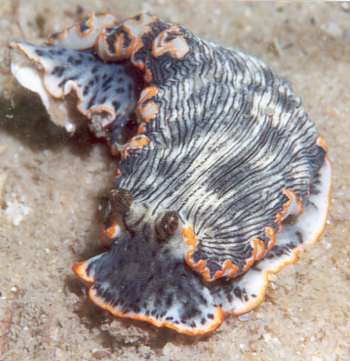
Dermatobranchus nigropunctatus
Baba, 1949
Order: NUDIBRANCHIA
Suborder: ARMININA
Family: Arminidae
DISTRIBUTION
Japan, and possibly eastern Australia
PHOTO
Little Beach, Marine Reserve, Port Stephens, NSW Australia.
Depth: 10 metres. Pacific Ocean. Length: 30 mm. 5 October 2004. Sandy bottom with scattered sponges & soft corals. Photographer: Leanne & David Atkinson
Originally described from Japan, the animal is described as having lines of small black spots running along the longitudinal ridges on the mantle. The mantle, foot and oral veil are lined with orange, and the white oral veil and foot have scattered black spots and patches. The rhinophores are described as 'brownish or orange'. The background colour of the mantle was described as 'olive ... with darker shades here and there'.
The animal illustrated here from eastern Australia agrees with this description except that the black spots on the dorsal ridges have become continuous balck line. If I'm correct, then this is a new record for Australia. It doesn't necessarily suggest this species is a recent arrival, it more likely means that we haven't been looking hard enough. It's also possible that a couple of photos from South Africa I identified as D. cf. gonatophora [messages #2146, #2176] are possibly D. nigropunctatus as well, but the Sth African animals have black rhinophores with no trace of the orange found in Australian and Japanese specimens.
-
Baba, K (1949) Opisthobranchia of Sagami Bay collected by His Majesty The Emperor of Japan. Iwanami Shoten, Tokyo. 194pp., 50 Pls.
Rudman, W.B., 2005 (April 18) Dermatobranchus nigropunctatus Baba, 1949. [In] Sea Slug Forum. Australian Museum, Sydney. Available from http://www.seaslugforum.net/find/dermnigr
Related messages
Dermatobranchus nigropunctatus from NSW, Australia
June 29, 2007
From: Jennifer Eaton

Hello
I found this critter at the Pipeline, Port Stephens, NSW, Australia. I think it may be some sort of Armina. However, it was out in the day.
It looked like the foot was white with black spots and orange on the edge of the mantle.
Locality: Pipeline, Port Stephens, 15 metres, NSW, Australia, Western Pacific, February 2007, weedy sand, occasional rubble. Length: 2 inches. Photographer: Jennifer Eaton.
Jennifer Eaton
jeneaton1@yahoo.com
Eaton, J., 2007 (Jun 29) Dermatobranchus nigropunctatus from NSW, Australia. [Message in] Sea Slug Forum. Australian Museum, Sydney. Available from http://www.seaslugforum.net/find/19479
Dear Jennifer,
I have identified this previously from Port Stephens as Dermatobranchus nigropunctatus. It's an interesting addition to the Australian east coast fauna.
Best wishes,
Bill Rudman
Dermatobranchus nigropunctatus from east Australia
April 19, 2005
From: L. & D. Atkinson


Dear Bill,
We also found this Armina that we can not identify at Little Beach during a daytime dive but the viz was poor so the low light conditions could have been mistaken for dusk. We found two of these small creatures on a Gorgonian with yellow polyps that is common in the area. The current was running and it was difficult to get a clear shot on the gorgonia so we moved one to the sand to photograph it and then replaced it.
Locality: Little Beach, Marine Reserve, Port Stephens, NSW Australia.
Depth: 10 metres. Pacific Ocean. Length: 30 mm. 5 October 2004. Sandy bottom with scattered sponges & soft corals. Photographer: Leanne & David Atkinson
It is good to see the Forum continue. We very much appreciate your efforts.
Cheers,
Leanne & David Atkinson
atk@hunterlink.net.au
Atkinson, L. & D., 2005 (Apr 19) Dermatobranchus nigropunctatus from east Australia. [Message in] Sea Slug Forum. Australian Museum, Sydney. Available from http://www.seaslugforum.net/find/13515
Dear Leanne & David,
This seems to me to be Dermatobranchus nigropunctatus Baba 1949, which as the authorship suggests is known only from Japan. In Baba's description the colour pattern on the back consists of lines of small black spots on the mantle, which in you animals form black lines. All the other colour details are the same.
If I'm correct, then this is a new record for Australia. It doesn't necessarily suggest this species is a recent arrival, it more likely means that we haven't been looking hard enough. It's also possible that a couple of photos from South Africa I identified as D. cf. gonatophora [messages #2146, #2176] are possibly D. nigropunctatus as well, but the Sth African animals have black rhinophores with no trace of the orange found in Australian an Japanese specimens.
Best wishes,
Bill Rudman
